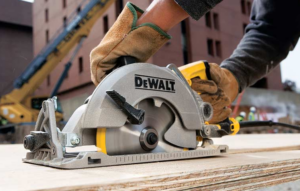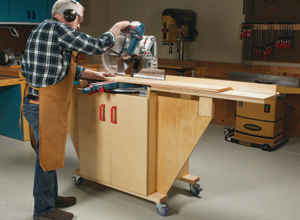A circular saw is a versatile power tool that can perform a wide range of cutting tasks. One question that often arises is whether a circular saw can be used as a miter saw. The answer is that it depends on the type of circular saw and the nature of the cutting task.
A miter saw is a specialized tool designed for making angled cuts, especially for molding and framing applications. It typically has a pivoting arm that allows the blade to be angled to the desired degree. A circular saw, on the other hand, is a handheld tool with a circular blade that spins rapidly to make straight cuts. While a circular saw can make angled cuts by tilting the blade, it is not designed for precision miter cuts. However, with the right attachments and accessories, it is possible to use a circular saw for some miter cutting tasks.
Understanding Circular Saws

Circular saws are a versatile tool that can be used for a variety of cutting tasks. They are commonly used for cutting wood, but they can also be used for cutting metal, plastic, and other materials. Circular saws have a circular blade that rotates at high speeds, making it possible to make precise cuts quickly and easily.
Circular saws come in different sizes, with the most common being the 7-1/4 inch and the 10-1/4 inch models. The size of the blade determines the depth of the cut that can be made. The larger the blade, the deeper the cut that can be made.
Circular saws can be used to make a variety of cuts, including crosscuts, rip cuts, and bevel cuts. Crosscuts are cuts made across the grain of the wood, while rip cuts are cuts made with the grain of the wood. Bevel cuts are cuts made at an angle to the surface of the wood.
Circular saws can be used with a variety of blades, including blades designed for cutting wood, metal, plastic, and other materials. The type of blade used will depend on the material being cut.
Circular saws can be used to make some types of cuts that are typically made with a miter saw, such as crosscuts and bevel cuts. However, they are not designed to make the precise, angled cuts that a miter saw is designed for. For this reason, a circular saw should not be used as a replacement for a miter saw when precise, angled cuts are required.
Understanding Miter Saws

A miter saw is a specialized saw used for making precise crosscuts and angled cuts in wood, metal, and other materials. It is commonly used in woodworking, construction, and DIY projects. The saw blade is mounted on a pivoting arm that can be adjusted to various angles, allowing the user to make angled cuts with precision.
Miter saws come in different types, including compound miter saws, sliding compound miter saws, and dual compound miter saws. Compound miter saws can tilt in one direction, while sliding compound miter saws can slide back and forth, allowing for wider cuts. Dual compound miter saws can tilt in both directions, making them more versatile.
Miter saws are ideal for making precise cuts for crown molding, baseboards, and other trim work. They can also be used for making angled cuts for picture frames, door frames, and other projects that require accurate cuts.
When using a miter saw, it is important to follow safety precautions, such as wearing eye and ear protection, keeping hands away from the blade, and securing the workpiece properly.
Overall, miter saws are a valuable tool for any woodworker or DIY enthusiast looking to make precise angled cuts.
Comparing Circular and Miter Saws
Circular saws and miter saws are two popular power tools used for cutting wood. While there are similarities between the two, there are also some key differences that set them apart.
Blade Differences
One of the most significant differences between circular saws and miter saws is the type of blade they use. Circular saws typically have a larger blade, ranging in size from 7 1/4 inches to 10 inches in diameter. These blades are designed for making straight cuts through thick pieces of wood.
Miter saws, on the other hand, use a smaller blade, typically ranging from 7 1/4 inches to 12 inches in diameter. These blades are designed for making precise angled cuts, making them a better choice for trim work and other detailed projects.
Cutting Capabilities
Circular saws are versatile tools that can make a variety of cuts, including straight cuts, bevel cuts, and rip cuts. They can also be used for cutting through a range of materials, including wood, metal, and plastic.
Miter saws are primarily designed for making angled cuts, including miter cuts, bevel cuts, and compound cuts. They are ideal for cutting trim and molding, as well as other detailed woodworking projects.
Accuracy and Precision
When it comes to accuracy and precision, miter saws are the clear winner. These tools are designed to make precise cuts at specific angles, making them ideal for projects that require a high level of accuracy.
Circular saws, while versatile, are not as precise as miter saws. They are better suited for rough cuts and projects where precision is not as important.
Overall, while a circular saw can be used as a miter saw in some cases, it is not a substitute for a dedicated miter saw. For projects that require precise angled cuts, a miter saw is the better choice.
Can a Circular Saw Replace a Miter Saw?
Circular saws and miter saws are both important tools in any woodworker’s arsenal. While they may look similar, they are designed for different tasks. A circular saw is ideal for making long, straight cuts, while a miter saw is designed for making precise angled cuts.
However, some people wonder if they can use a circular saw instead of a miter saw. The short answer is yes, but it depends on the type of cut you need to make.
One of the main differences between a circular saw and a miter saw is the ability to make angled cuts. While a miter saw can easily make angled cuts, a circular saw requires a bit more effort. You can use a circular saw to make angled cuts by adjusting the blade angle and using a guide, but this method is not as precise as a miter saw.
Another difference is the ability to make repetitive cuts. A miter saw is designed to make precise cuts at the same angle over and over again, which is ideal for tasks such as cutting trim or molding. While you can use a circular saw to make repetitive cuts, it requires more time and effort to ensure each cut is the same.
Overall, a circular saw can be used as a substitute for a miter saw in certain situations, but it is not a complete replacement. If you need to make precise angled cuts or repetitive cuts, a miter saw is the better choice. However, if you only need to make straight cuts or occasional angled cuts, a circular saw can get the job done.
Safety Considerations
When using a circular saw as a miter saw, there are several safety considerations that must be taken into account. Failure to follow these safety guidelines could result in serious injury or even death.
Firstly, it is important to always wear appropriate personal protective equipment (PPE) such as safety glasses, ear protection, and gloves. This will help protect the user from flying debris and other hazards.
Secondly, the saw blade must be properly secured and tightened before use. Loose blades can cause the saw to kick back or even come off during operation, which can be extremely dangerous.
Thirdly, the saw must be positioned on a stable surface and clamped securely in place. This will help prevent the saw from moving during operation, which can also be dangerous.
Fourthly, the user must ensure that the blade is properly aligned with the cutting line and that the saw is set to the correct depth. This will help prevent the blade from binding or kicking back.
Lastly, it is important to always keep hands and fingers away from the blade while it is in motion. This can be accomplished by using a push stick or other appropriate tool to guide the material being cut.
By following these safety considerations, users can minimize the risk of injury and safely use a circular saw as a miter saw.
Pros and Cons of Using Circular Saw as Miter Saw
When it comes to woodworking, having the right tools is essential. A miter saw is a common tool used to make precise angled cuts, but not everyone has access to one. In such cases, a circular saw can be used as a substitute for a miter saw. However, there are both pros and cons to using a circular saw as a miter saw.
Pros
- Cost-effective: Circular saws are generally less expensive than miter saws, making them a more budget-friendly option for those who only need to make angled cuts occasionally.
- Portability: Circular saws are lightweight and easy to transport, making them a good option for those who need to work on projects in different locations.
- Versatility: Circular saws can be used for a variety of tasks beyond just making angled cuts, making them a more versatile tool to have in your workshop.
Cons
- Accuracy: While circular saws can make angled cuts, they are not as precise as miter saws. This can result in uneven or inaccurate cuts, which can be frustrating and time-consuming to fix.
- Safety: Circular saws are more dangerous than miter saws due to their design. They are handheld, which increases the risk of injury if not used properly. Additionally, circular saws generate a lot of dust, which can be harmful if inhaled.
- Limited Capacity: Circular saws have a smaller cutting capacity than miter saws, which can be a disadvantage when working with larger pieces of wood or other materials.
Overall, using a circular saw as a miter saw can be a good option for those who don’t have access to a miter saw or only need to make angled cuts occasionally. However, it’s important to keep in mind the limitations and potential safety risks when using a circular saw for this purpose.
Conclusion
In summary, while a circular saw can be used as a miter saw with the right accessories, it is not a perfect substitute.
Using a circular saw as a miter saw requires the use of a guide or jig to ensure accurate cuts. Additionally, the smaller blade size of a circular saw may limit the thickness of materials that can be cut.
While a circular saw may be a more affordable option, a miter saw is designed specifically for making angled cuts and provides greater precision and versatility.
Ultimately, the decision to use a circular saw as a miter saw comes down to personal preference and the specific needs of the project. However, for those who require accurate and consistent angled cuts, a miter saw is the recommended tool.
Reader Interactions